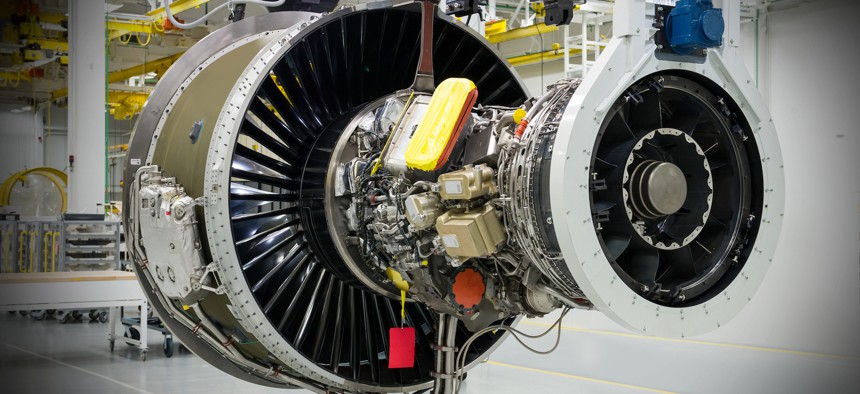
Kawasaki Heavy Industries PW1500G Kawasaki Heavy Industries PW1500G
The Virtual Tools That Built the Air Force’s New Fighter Prototype
“Digital twinning” is coming to a battlefield near you.
The Air Force’s newly revealed fighter-jet prototype was designed with immersive simulations and other new digital tools that herald a new era for the creation and production of the U.S. military’s weapons.
Service officials released next to no details about the Next Generation Air Dominance program, or NGAD, whose flight demonstrator has apparently already broken some records. What is known is that the Air Force and its contractors designed the plane virtually, using data and new techniques that allowed the service to build and test it in a fraction of the time required for, say, the F-35, which took more than a decade to build.
“What having the ‘eplane’ will allow us to do is get much faster through design, much faster through assembly, get out to test faster and be able to go after the data we need to anchor models,” chief acquisition executive Will Roper told reporters Tuesday. “So these digital threads that are pulled through the life cycle of the program, appear to accelerate everything. The windfall of accelerating everything is getting to focus on what actually matters because the digital model is allowing you to convey things that you already know.”
Virtualization by itself isn’t new. What is new is the computing power and availability of data to make digital versions of real objects credible and useful at a new scale. This practice of digital twinning goes back to a 2002 presentation by engineer Michael Grieves, then working for the University of Michigan’s Product Lifecycle Management Center. As originally conceived, the twin was a digital version of a real thing, created not through simple computer-aided design techniques but from data produced by sensors on the real object.
“The premise driving the model was that each system consisted of two systems, the physical system that has always existed and a new virtual system that contained all of the information about the physical system,” Grieves wrote in a 2016 paper “This meant that there was a mirroring or twinning of systems between what existed in real space to what existed in virtual space and vice versa.”
He added that the Defense Department was exploring the concept for the next-generation fighter jet design.
For the NGAD, the Air Force used data from the F-35 Joint Strike Fighter and the T-7 trainer to develop a virtual prototype, and then a physical, flying aircraft.
“The announcement isn’t that we just built an ‘eplane,’ and have flown it a lot of times in our virtual world, which we’ve done, but that we have built a full-scale flight demonstrator and flown it in the real world,” said Roper.
Moreover, it shows that the Air Force has enough data to develop a variety of eplanes quickly, either to tweak existing designs or build new ones from scratch. For example, Roper said, that if he had to build another trainer to follow the T-7, it would need a lot less testing.
Digital twinning is hardly unique to the Air Force. Apple does it for iPhones, while Tesla creates a digital twin of every vehicle it builds. Sensors aboard the vehicle alert Tesla about problems, and divine whether it needs to be fixed by a mechanic or a remote software update. All that sensor data also goes into new and better designs that are based around what the cars experience in the real world.
The Defense Department has been moving into the space as well. In April 2018, Michael Griffin, then defense undersecretary for research and engineering, told lawmakers about the need to bring virtualization and simulation into the process of building weapons, networks, and equipment.
“We are developing a capability to integrate validated Service and threat models into a Joint simulation environment so that we can conduct high fidelity evaluations of these potential capabilities in a mission level scenario so that the Department can gain a better understanding of how these capabilities will work,” Griffin said. Later that year, he went on to push the Department to adopt a new digital engineering strategy.
Last year, the Pentagon contracted a firm called Uptake to build a virtual twin of the Bradley Fighting Vehicle to better predict maintenance problems. In the future, Roper suggested that the technique will help develop everything from satellites to intercontinental ballistic missiles.
Grieves, the originator of the concept, recently said in an interview that applications for digital twining extend to aircraft carriers or really anything that the military builds.
“Put an observer in the room and show an image of a virtual product and a physical product side-by-side,” he said. “Today almost no one can tell the difference.”




